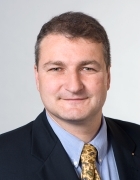
Prof. Dr. Reinhard Kienberger
Academic Career and Research Areas
The research area of professor Kienberger (b. 1971) is attosecond physics. Together with his team, he uses high-energy ultra-short laser pulses to create the shortest light pulses ever made. These are as short as 80 attoseconds. An attosecond is 10-18 of a second. In orders of magnitude the difference between an attosecond and a second is the same as the difference between a second and the age of the universe. With these short pulses the electronic processes in atoms, molecules and solid matter can be time-resolved. These findings show promise and are likely to lead to advances in molecular electronics, biophysics, photovoltaics and nanosystems.
Kienberger studied and completed his doctorate (2002) at TU Vienna, where he carried out the first measurement of attosecond pulses, for which his supervisor Ferenc Krausz was awarded the Nobel Prize in 2023. A scholarship awarded by the Austrian Academy of Sciences (ÖAW) enabled him to work as a postdoctoral researcher at the Stanford Linear Accelerator Laboratory, USA (2004). Since 2006, he has led a research group at the Max Planck Institute for Quantum Optics in Garching, from 2014 to 2019 as a Max Planck Fellow. In the context of the Munich Centre for Advanced Photonics (MAP) Excellence Cluster, he was appointed Professor of Experimental Physics at TUM in 2008. Since 2013, Prof. Kienberger is head of the chair E11, Laser and X-ray Physics. In March 2018, he became a member of the University Council at Graz University of Technology. Kienberger's 143 publications have been cited approx. 15,000 times, h-factor 41 (2023).
Awards
- Prize for Research in Laser Science and Applications, European Physical Society (2016)
- ERC Consolidator Grant (2014)
- ICO Prize in Optics, International Comission for Optics (2010)
- ERC Starting Grant (2008)
- Sofja Kovalevskaja-Preis der Alexander von Humboldt Stiftung (2006)
Key Publications (all publications)
Ossiander M, Riemensberger J, Neppl S, Mittermair M, Schäffer M, Duensing A, Wagner MS, Heider R, Wurzer M, Gerl M, Schnitzenbaumer M, Barth JV, Libisch F, Lemell C, Burgdörfer J, Feulner P, Kienberger R: „Absolute timing of the photoelectric effect”. Nature. 2018; 561: 374.
AbstractNeppl S, Ernstorfer R, Cavalieri AL, Lemell C, Wachter G, Magerl E, Bothschafter EM, Jobst M, Hofstetter M, Kleineberg U, Barth JV, Menzel D, Burgdörfer J, Feulner P, Krausz F, KienbergerR: „Direct observation of electron propagation and dielectric screening on the atomic length scale.” Nature. 2015; 517: 342-346.
AbstractHelml W, Maier AR, Schweinberger W, Grguraš I, Radcliffe P, Doumy G, Roedig C, Gagnon J, Messerschmidt M, Schorb S, Bostedt C, Grüner F, DiMauro LF, Cubaynes D, Bozek JD, Tschentscher T, Costello JT, Meyer M, Coffee R, Düsterer S, Cavalieri AL, Kienberger R: „Measuring the temporal structure of few-femtosecond free-electron laser X-ray pulses directly in the time domain”. Nature Photonics. 2014; 8: 950–957.
AbstractWittmann T, Horvath B, Helml W, Schätzel MG, Gu X, Cavalieri AL, Paulus GG, Kienberger R: “Single-shot carrier-envelope phase measurement of few-cycle laser pulses”. Nature Physics. 2009; 5: 357-362.
AbstractKienberger R, Goulielmakis E, Uiberacker M, Baltuska A, Yakovlev V, Bammer M, Scrinzi A, Westerwalbesloh T, Kleineberg U, Heinzmann U, Drescher M, Krausz F: "Atomic transient recorder". Nature. 2004; 427: 817-821.
AbstractIf you wish your profile to be changed or updated please contact Franz Langer.